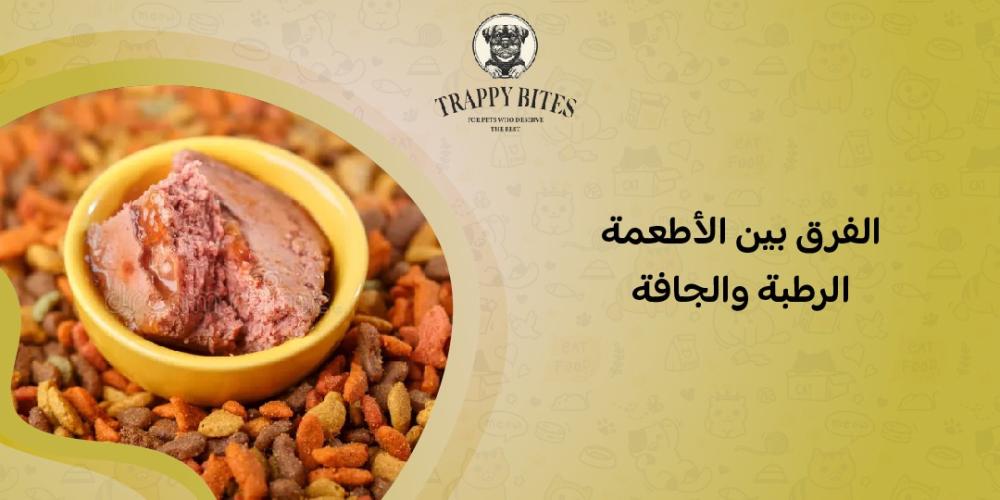When it comes to feeding your cat, choosing the right food is a vital decision that directly impacts their health and well-being. But have you ever considered the difference between wet and dry food? At Trappy Bites, we'll reveal the key differences between these two types of food, helping you make the ideal decision that meets your cat's nutritional needs and promotes their health. So, whether you're looking for a food that provides extra hydration or balanced, long-lasting nutrition, we're here to guide you to the best option for your furry friend.
The difference between wet and dry foods
The main difference between dry and wet food lies in the moisture content. Dry food contains less than 20% moisture, and this percentage varies depending on the product and brand. In contrast, wet food contains more than 60% moisture, and this percentage also varies depending on the product and brand.
Although the ingredients may be similar between the two types, the difference between wet and dry foods is:
The manufacturing method differs. Dry food is made by cooking protein sources and then adding vitamins, minerals, and fats. Wet food, on the other hand, is prepared by grinding animal protein sources and adding the required vitamins and minerals.
The most important differences between wet and dry foods
When we discuss the difference between wet and dry foods, the difference here lies in a set of points that include:
- manufacturing process
Dry and wet cat and dog food differ significantly in their manufacturing process. Dry foods are made through a process known as extrusion, where the food is forced through a small orifice and cooked under high pressure. In contrast, wet foods are made through a processing process, where the ingredients are mixed with water, then cooked and packaged in cans.
- Moisturizing
Wet food has a high water content, reaching 75-78%, compared to dry food, which only contains 6-10% water. This makes wet food closer to the natural diet of cats and dogs, as they get most of their water needs from food.
- Nutrients
Dry food typically contains higher amounts of carbohydrates than wet food, while wet food has higher levels of protein, fat, sodium, and phosphorus. This difference between wet and dry foods makes it essential to consider the individual needs of dogs and cats when choosing a food type.
- Consistency
Another difference between wet and dry foods is that the preferences of dogs and cats play a major role in choosing the right food. Some pets prefer crunchy food, while others prefer wet food with a strong flavor. Therefore, it is important to monitor the behavior of cats and dogs during mealtime to determine the type of food that suits them.
Pros and Cons of Wet and Dry Food
After learning the difference between wet and dry foods, there are a number of pros and cons that distinguish each, which are as follows:
Advantages of wet food:
These advantages include:
- Wet food has a lower calorie density and less carbohydrate than dry food, making it a good choice for overweight cats and dogs.
- The high water content in wet food helps hydrate dogs and cats, which is beneficial for these animals that forget to drink water or suffer from conditions such as constipation or kidney problems.
- Dogs and cats suffering from respiratory infections or sinus congestion may prefer wet food because of its strong, attractive smell.
Disadvantages of wet food:
Knowing the difference between wet and dry foods, the downside of wet food is that after opening the can of wet food, it must be used within 24 hours, which is not suitable for dogs and cats who prefer to eat throughout the day.
Advantages of dry food:
These advantages include:
- Dry food is more convenient for busy families and animals that graze all day, and it stays fresh for more than 24 hours after serving.
- Dry food can be beneficial for dogs and cats that are underweight or losing muscle mass, especially in older animals.
Disadvantages of dry food:
One of the biggest drawbacks of wet and dry food is that dry food is usually more calorie dense, which may not be suitable for overweight or obese cats and dogs, as it can lead to health problems such as diabetes.
How do you choose the right meal for your pet?
After learning the difference between wet and dry foods and the pros and cons of each, choosing the ideal meal for your pet depends not only on comparing the advantages and disadvantages of dry and wet food mentioned above, but also on several important factors.
These factors include the animal's weight, general health, age, the proportions of components and nutrients in its body, and its appetite and appetite for food. Therefore, it is always recommended to take your pet to a veterinarian, who will determine the most appropriate type of food, in addition to determining the ideal quantity and requirements for other types of food.
Premium wet and dry foods from Trabby Bites
Choose the best for your pet today, through the products of the Trabi Bites store, and see the difference in its health and vitality every day. Among our distinguished products are the following:
- dried sardines
Enjoy providing the best for your pet with dried sardines from Trabi Bites Store. Dried sardines are a 100% natural meal rich in proteins and omega-3, ensuring your pet has strong health, shiny skin, and strong bones.
Features of dried sardines
- 100% natural and preservative-free.
- Rich in proteins and omega 3, which promotes your pet's overall health.
- Supports healthy skin, hair, and bones.
- It enhances heart function and improves digestive system performance.
- Suitable for both cats and dogs, providing a comprehensive solution.
- It contributes to maintaining oral health and reducing bacterial formation.
- chicken broth
Give your pet optimal nutrition with our natural and delicious chicken broth products from Trabi Bites. They are the perfect solution to improve your dog or cat's nutrition, thanks to their richness in collagen and vitamins, which promote joint health and digestion, while also making them a delicious addition to their daily diet.
Benefits of fish for cats
Fish is a rich source of beneficial nutrients for cats, especially omega-3 fatty acids, which contribute to improved skin and hair health, making the coat shinier and healthier. Fish also helps boost immune health and strengthen the heart and blood vessels. In addition, fish contains high-quality proteins that support muscle growth and help maintain an ideal weight. Eating fish can also be beneficial for joint health thanks to its anti-inflammatory properties. It is important to feed fish in moderation and cook it well to avoid any health problems.
Is cooked fish harmful to cats?
Cooked fish is generally not harmful to cats, and can even be beneficial if served appropriately. Fish contains omega-3 fatty acids, which contribute to healthy skin and coat and improved brain function. However, it must be thoroughly cooked without adding spices or oils, and the bones must be completely removed to avoid the risk of choking or gastrointestinal injury. It is best to serve fish in moderation because it is rich in protein, and eating large amounts can lead to health problems such as high mercury levels in the body. Therefore, it is important to serve fish in moderation and as part of a balanced diet for cats.
Features of chicken broth
- Economical and healthy, it is one of the cheapest options for improving dog nutrition.
- Helps moisturize your dog's body and promote healthy skin and coat.
- It contains a high percentage of collagen, which strengthens joints and bones.
- Supports digestive health and improves digestion.
- Flexible in use, as it can be added to dry or wet food.
- Made from high quality natural ingredients of chicken meat and bones.
- The slow cooking process ensures that essential vitamins and minerals are extracted.
Whether you prefer water-rich wet foods or crunchy, nutritious dry foods, understanding the difference between them will help you make the perfect decision. Join the thousands of pet owners who rely on Trappy Bites to provide optimal nutrition for their loved ones.

